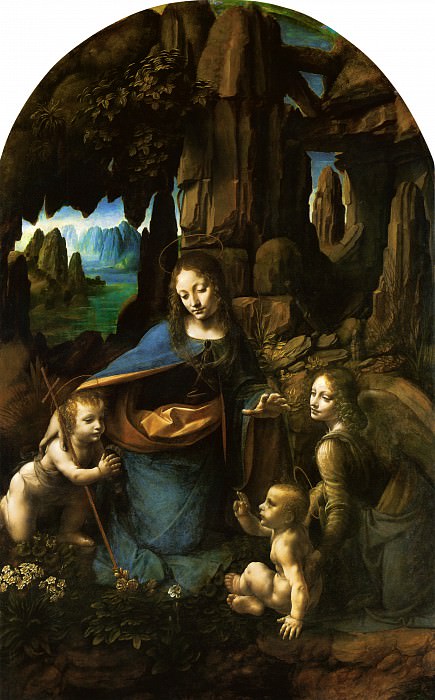Madonna of the Rocks Leonardo da Vinci (1452-1519)
Leonardo da Vinci – Madonna of the Rocks
Edit attribution
Download full size: 2291×3690 px (1,5 Mb)
Painter: Leonardo da Vinci
This work of art was executed in oil on panel and subsequently transferred to canvas by Leonardo Da Vinci from the period one thousand four hundred and eighty-third to one thousand four hundred and eighty-sixth. The main feature of this work is that it is one of the paintings that fully managed to reveal all the skills of the great painter Leonardo Da Vinci. This painting is in the form of an icon which was commissioned by the monks of St.
Description of Leonardo da Vinci’s painting Madonna in the Grotto (Madonna in the Rocks)
This work of art was executed in oil on panel and subsequently transferred to canvas by Leonardo Da Vinci from the period one thousand four hundred and eighty-third to one thousand four hundred and eighty-sixth.
The main feature of this work is that it is one of the paintings that fully managed to reveal all the skills of the great painter Leonardo Da Vinci. This painting is in the form of an icon which was commissioned by the monks of St. Francis Church as a decoration for the church altar.
At the time of its inception, the painting had a frame in the form of a carved wooden altar. During the execution of the order the artist had assistants, but the most responsible work related to the painting of the central area was performed, of course, by the great painter.
It is worth noting that this work is quite a landmark for the artist, as it is in this work, the great master was able to implement a seamless harmony of human figures with the landscape. This is what later served as one of his very important skills in the following works.
This painting has rightly earned the status of Da Vinci’s first mature work, as it is one in which the painter was able to reflect his talent as an artist and put his whole soul into it. Moreover, in the work each part and detail is depicted in perfect harmony with each other and presented to the viewer as a whole.
There are no separate figures, but there is just a unity, which is joined by shadow and soft color interacting harmoniously and giving the viewer a sense of warmth and at the same time fascinating with its mysterious mysteries of existence.
Кому понравилось
Пожалуйста, подождите
На эту операцию может потребоваться несколько секунд.
Информация появится в новом окне,
если открытие новых окон не запрещено в настройках вашего браузера.
You need to login
Для работы с коллекциями – пожалуйста, войдите в аккаунт (open in new window).




















COMMENTS: 3 Ответы
Это не оригинал!
Анна, покажите ссылку на оригинал
В 1483 году Братство Непорочного Зачатия заказало Леонардо центральную алтарную картину для церкви Сан Франческо Гранде в Милане (ныне разрушенной). Сюжет предполагал изображение встречи маленьких Христа и Иоанна Крестителя в присутствии Девы Марии и ангела в просторном гроте. Луврская картина была написана сравнительно быстро; но потом между художником и заказчиками возникли разногласия, улаженные лишь в 1508 году, когда Леонардо завершил вторую версию " Мадонны в скалах", находящуюся ныне в Лондонской Национальной Галерее, и заменил ею первую. Есть данные, что Лодовико Моро подарил первую версию Максимилиану Габсбургу. Картины почти не отличаются, но вместе с тем представляют два различных этапа в творчестве Леонардо и две различные интерпретации Мадонны как центральной фигуры Непорочного Зачатия.
You cannot comment Why?
The subtexts of the painting are rich and multifaceted, characteristic of Leonardo da Vincis work. The rocky setting, with its interplay of light and shadow, can be interpreted as a symbol of the sanctuary and protection the Virgin offers, but also hints at the difficult journey and eventual suffering Christ will face. The presence of both infant Jesus and John the Baptist together, in this intimate and perhaps unexpected setting (as opposed to a traditional Nativity or Annunciation scene), highlights the future relationship and roles of the divine figures. Johns cross prefigures Christs crucifixion, adding a layer of foreshadowing and religious prophecy. The angels presence can be understood as a divine messenger and guardian, underscoring the sacred nature of the encounter. The overall atmosphere is one of serene mystery and spiritual significance, inviting contemplation on themes of divine protection, destiny, and the hidden meanings within sacred narratives.